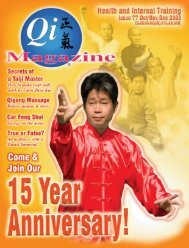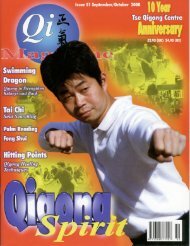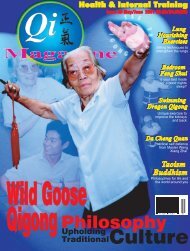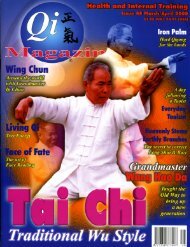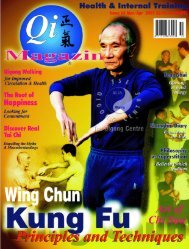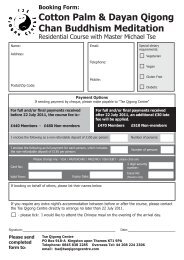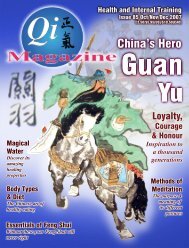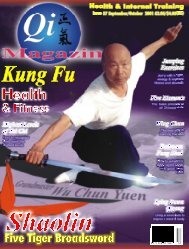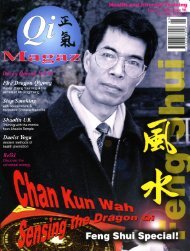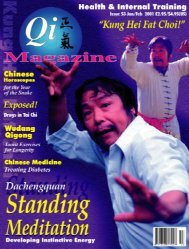Issue 49 - Tse Qigong Centre
Issue 49 - Tse Qigong Centre
Issue 49 - Tse Qigong Centre
- No tags were found...
You also want an ePaper? Increase the reach of your titles
YUMPU automatically turns print PDFs into web optimized ePapers that Google loves.
Fig 59 Fig 60 Fig 61Fig 62We also have mentioned the Fuk Sau in theprevious issue of Qi Magazine. However, thisFuk Sau position is slightly different from theone before. The Fuk Sau we learned before isfor the situation when your opponent is slightlyweaker than you and you are able to stop theirenergy with your forearms. This one is for whenyour opponent is stronger than you. Thereforeyou contact them with your palm to feel theirenergy instead of trying resist their energy.When they try to attack you, you can thenrespond immeditately(see Wing Chun KungFu - Traditional Chinese Kung Fu for SelfDefence and Health page 111).Double Jut Sau1. Jerk your hands backward and slightlydownward, along the line of yourforearms, in a small movement.(Fig.59)Jut means “Jerk”. It means “jerking hand”.When your opponent’s arms are very tense, andyou are contacting them with your Fuk Sau,then you can use Jut Sau. If used properly,then your opponent will lose their balance.However, do not use when their hands are soft,only when they are using energy (see WingChun Kung Fu - Traditional Chinese KungFu for Self Defence and Health page 111).Double Biu Jee1. Thrust your hands forward at eyelevel, as if you are attacking youropponent’s eyes. Push energy to yourfinger tips at the last moment.(Fig. 60)Biu means “strike”, Jee means “fingers”. Itmeans “strike with fingers”. Biu Jee is a highlevel of Wing Chun Kuen skill. In Chinesemartial arts training, we allknow that the fist is verypowerful, but it is not aspowerful as the palm. The palmis not as powerful as the fingers.Therfore if we attack with thefingers, it will do more damagethan by using just a fist. Thisis because when we use the fingersto attack, we attack the weakerareas of the body, not the hardpart of the body. Because ofthis, it is very hard to recover.In the form, we use Biu Jee toattack after we have brought ouropponent’s balance forwardusing Jut Sau. When they areleaning forward, they will have little defencewhen you attack their eyes. However, intraditional Wing Chun training, the Sifuusually does not teach the Biu Jee Form untilthey trust their students. Bui Jee is also used toattack the weaker acupuncture points in thebody.Double Lat Sau1. Keep your arms straight, push thehands downward with force until youreach the waist level. (Fig.61)Lat means “force goes downward”. It means“force down hand”. Lat Sau is not usedcommonly, because it uses strength. In theprinciple of Wing Chun, we use as little energyas possible. So Lat Sau is for covering a BuiJee attack which fails. In case your opponentblocks your Bui Jee attack with their hands,then you can push them down again. It issimilar to Jut Sau (Wing Chun Book page111).Withdraw the fists1. Bring up both hands to the shoulderlevel with both wrists upward.(Fig 62)2. This part we have mentioned beforein issues 47 and 48. This time we dothem with both hands together.(Fig.63 & 64)Remember that Siu Lim Tao is basic WingChun Kuen skill. If you want to develop goodWing Chun Kuen, you spend the time on SiuLim Tao to make your skill good.to be continued ...Fig 63 Fig 64Qi Magazine 41



